Estimation of Soil Erosion and Enhancing Sediment Retention in the Lam Phra Phloeng Watershed: Insights from RUSLE and InVEST Modelling
Abstract
1. Introduction
2. Study Area
3. Datasets and Methodology
3.1. Datasets Used
3.1.1. RUSLE Model
3.1.2. InVEST SDR Model
3.2. Methodology
4. Results
4.1. Land Use Mapping
4.2. Soil Loss and Sediment Retention in Lam Phra Phloeng
5. Discussion
6. Conclusions
7. Recommendations
Author Contributions
Funding
Data Availability Statement
Acknowledgments
Conflicts of Interest
References
- FAO. Voluntary Guidelines for Sustainable Soil Management. 2017. Available online: https://openknowledge.fao.org/server/api/core/bitstreams/9a5b9373-3558-43b3-b732-f69326a7314d/content (accessed on 10 July 2025).
- UNEP. Why Restoring Nature is Good for Farmers, Fisheries and Food Security. Available online: https://www.unep.org/news-and-stories/story/why-restoring-nature-good-farmers-fisheries-and-food-security (accessed on 10 July 2025).
- WWF. What Is Erosion? Effects of Soil Erosion and Land Degradation. Available online: https://www.worldwildlife.org/threats/soil-erosion-and-degradation (accessed on 10 July 2025).
- Van Cotthem, W. Soil Erosion and Degradation—DESERTIFICATION. Available online: https://desertification.wordpress.com/2019/04/08/soil-erosion-and-degradation/ (accessed on 10 July 2025).
- FAO. Key Messages|Global Symposium on Soil Erosion|Food and Agriculture Organization of the United Nations. Available online: https://www.fao.org/about/meetings/soil-erosion-symposium/key-messages/en/ (accessed on 10 July 2025).
- Banerjee, S.; Das, S.; Kandekar, A.M.; Scaringi, G.; Sangode, S.J. Scale-dependency, rainfall, and lithologic controls on the hypsometry of the Western Ghats, India. J. Earth Syst. Sci. 2023, 132, 49. [Google Scholar] [CrossRef]
- Pansak, W.; Takrattanasaran, N.; Nongharnpitak, N.; Khongdee, N. Soil-Related Laws in Thailand. In International Yearbook of Soil Law and Policy; Springer: Cham, Switzerland, 2024; Volume 2022, pp. 243–262. [Google Scholar] [CrossRef]
- Somprakon, S.; Yothapakdee, T.; Howpinjai, I.; Painkhit, P.; Yodkeaw, S.; Kruama, K.; Lattirasuvan, T. Soil Fertility and Carbon Sequestration Assessment in 8-Year Restored Forest Area, Phrae Province. Thai J. Forestry. Available online: https://li01.tci-thaijo.org/index.php/tjf/article/view/261433 (accessed on 10 July 2025).
- Ekasingh, B.; Gypmantasiri, P. Maize in Thailand: Production Systems, Constraints, Research Priorities. 2004. Available online: www.cimmyt.org (accessed on 10 December 2024).
- Tsubo, M.; Basnayake, J.; Fukai, S.; Sihathep, V.; Siyavong, P.; Chanphengsay, M. Toposequential effects on water balance and productivity in rainfed lowland rice ecosystem in Southern Laos. Field Crops Res. 2006, 97, 209–220. [Google Scholar] [CrossRef]
- FAO. Intergovernmental Technical Panel on Soils; FAO: Rome, Italy, 2015.
- Pimentel, D.; Burgess, M. Soil erosion threatens food production. Agriculture 2013, 3, 443–463. [Google Scholar] [CrossRef]
- Borrelli, P.; Robinson, D.A.; Fleischer, L.R.; Lugato, E.; Ballabio, C.; Alewell, C.; Meusburger, K.; Modugno, S.; Schütt, B.; Ferro, V.; et al. An assessment of the global impact of 21st century land use change on soil erosion. Nat. Commun. 2017, 8, 2013. [Google Scholar] [CrossRef] [PubMed]
- Dinar, A.; Tieu, A.; Huynh, H. Water Scarcity Impacts on Global Food Production. Glob. Food Secur. 2019, 23, 212–226. [Google Scholar] [CrossRef]
- Zurich. Why Soil is Important to Life on Earth—And Helps Fight Climate Change|Zurich Insurance. Available online: https://www.zurich.com/media/magazine/2021/how-soil-supports-life-on-earth-and-could-help-win-the-fight-against-climate-change (accessed on 10 July 2025).
- Zhou, Z.C.; Shangguan, Z.P.; Zhao, D. Modeling vegetation coverage and soil erosion in the Loess Plateau Area of China. Ecol. Model. 2006, 198, 263–268. [Google Scholar] [CrossRef]
- Banerjee, S.; Pal, I.; Loc, H.H. Modeling the impacts of climate and land use changes on nutrient export using the INVEST model in Tra Vinh Province of the Vietnamese Mekong Delta. In The Mekong Delta Environmental Research Guidebook; Elsevier: Amsterdam, The Netherlands, 2025; pp. 349–363. [Google Scholar] [CrossRef]
- Renard, K.G. Predicting Soil Erosion by Water: A Guide to Conservation Planning with the Revised Universal Soil Loss Equation (RUSLE); United States Department of Agriculture, Agricultural Research Service: Washington, DC, USA, 1997.
- Kareiva, P.; Tallis, H.; Ricketts, T.H.; Daily, G.C.; Polasky, S. Natural Capital: Theory and Practice of Mapping Ecosystem Services; SAGE Publications Ltd.: London, UK, 2011. [Google Scholar] [CrossRef]
- Bishop, C.M. Pattern Recognition and Machine Learning. Available online: https://link.springer.com/book/9780387310732 (accessed on 10 July 2025).
- Arnold, J.G.; Moriasi, D.N.; Gassman, P.W.; Abbaspour, K.C.; White, M.J.; Srinivasan, R.; Santhi, C.; Harmel, R.D.; van Griensven, A.; Van Liew, M.W.; et al. SWAT: Model Use, Calibration, and Validation. Trans. ASABE 2012, 55, 1491–1508. Available online: https://swat.tamu.edu/media/99051/azdezasp.pdf (accessed on 8 December 2024). [CrossRef]
- Abbaspour, K.C. SWAT-CUP SWATCalibration and Uncertainty Programs; Eawag: Dübendorf, Switzerland, 2015. [Google Scholar]
- Hazbavi, Z.; Sadeghi, S.H.; Gholamalifard, M. Dynamic Analysis of Soil Erosion-Based Watershed Health. Geogr. Environ. Sustain. 2019, 12, 43–59. [Google Scholar] [CrossRef]
- Phetprayoon, T.; Sarapirome, S.; Navanugraha, C.; Wonprasaid, S. Surface Runoff Estimation Using Grid-Based Curve Number Method in the Upper Lam Phra Phloeng Watershed, Thailand. 2009. Available online: https://www.researchgate.net/publication/266052436 (accessed on 10 December 2024).
- Lorsirirat, K. Effect of Forest Cover Change on Sedimentation in Lam Phra Phloeng Reservoir, Northeastern Thailand. In Forest Environments in the Mekong River Basin; Springer: Tokyo, Japan, 2007. [Google Scholar]
- Cho, K.M.; Zoebisch, M.A.; Cho, K.M.; Zoebisch, M.A. Land-Use Changes in the Upper Lam Phra Phloeng Watershed, Northeastern Thailand: Characteristics and Driving Forces. J. Agric. Rural. Dev. Trop. Subtrop. 2003, 104, 15–29. [Google Scholar]
- Wahid, S.M.; Babela, M.S. Evaluating Landscape Predictors with Reference to Watershed Hydrology: A Case Study from Lam Phra Phloeng Watershed, Northeast Thailand. Asia Pac. J. Rural. Dev. 2008, 18, 41–56. [Google Scholar] [CrossRef]
- Vigiak, O.; Borselli, L.; Newham, L.T.H.; McInnes, J.; Roberts, A.M. Comparison of conceptual landscape metrics to define hillslope-scale sediment delivery ratio. Geomorphology 2012, 138, 74–88. [Google Scholar] [CrossRef]
- Borselli, L.; Cassi, P.; Torri, D. Prolegomena to sediment and flow connectivity in the landscape: A GIS and field numerical assessment. Catena 2008, 75, 268–277. [Google Scholar] [CrossRef]
- Ekanayaka, H.B.G.D.M.P.; Abeysingha, N.; Amarasekara, M.G.T.S.; Samarathunga, D. The Use of InVEST SDR Model to Evaluate Soil Erosion in the Closer Catchment of the Proposed Lower Malwathu Oya Reservoir, Sri Lanka. 2024. Available online: https://ssrn.com/abstract=4815789 (accessed on 10 December 2024).
- Chuenchum, P.; Xu, M.; Tang, W. Predicted trends of soil erosion and sediment yield from future land use and climate change scenarios in the Lancang–Mekong River by using the modified RUSLE model. Int. Soil Water Conserv. Res. 2020, 8, 213–227. [Google Scholar] [CrossRef]
- Markose, V.J.; Jayappa, K.S. Soil loss estimation and prioritization of sub-watersheds of Kali River basin, Karnataka, India, using RUSLE and GIS. Environ. Monit. Assess. 2016, 188, 225. [Google Scholar] [CrossRef] [PubMed]
- Fayas, C.M.; Abeysingha, N.S.; Nirmanee, K.G.S.; Samaratunga, D.; Mallawatantri, A. Soil loss estimation using rusle model to prioritize erosion control in KELANI river basin in Sri Lanka. Int. Soil Water Conserv. Res. 2019, 7, 130–137. [Google Scholar] [CrossRef]
- Panagos, P.; Borrelli, P.; Meusburger, K.; van der Zanden, E.H.; Poesen, J.; Alewell, C. Modelling the effect of support practices (P-factor) on the reduction of soil erosion by water at European scale. Environ. Sci. Policy 2015, 51, 23–34. [Google Scholar] [CrossRef]
- Elleaume, N.; Locatelli, B.; Makowski, D.; Vallet, A.; Poulenard, J.; Oszwald, J.; Lavorel, S. Uncertainties in future ecosystem services under land and climate scenarios: The case of erosion in the Alps. Ecol. Model. 2025, 502, 111041. [Google Scholar] [CrossRef]
- Nelson, E.; Mendoza, G.; Regetz, J.; Polasky, S.; Tallis, H.; Cameron, D.; Chan, M.A.; Daily, G.C.; Goldstein, J.H.; Kareiva, P.; et al. Modeling multiple ecosystem services, biodiversity conservation, commodity production, and tradeoffs at landscape scales. Front. Ecol. Environ. 2009, 7, 4–11. [Google Scholar] [CrossRef]
- Sharp, R.; Tallis, H.T.; Ricketts, T.; Guerry, A.D.; Wood, S.A.; Chaplin-Kramer, R.; Nelson, E.; Ennaanay, D.; Wolny, S.; Olwero, N.; et al. InVEST 3.2. 0 User’s Guide. Available online: https://www.researchgate.net/profile/Gregory-Verutes/publication/323832082_InVEST_User‘s_Guide/links/5aad657ea6fdcc1bc0badaab/InVEST-Users-Guide (accessed on 10 July 2025).
- Hamel, P.; Chaplin-Kramer, R.; Sim, S.; Mueller, C. A new approach to modeling the sediment retention service (InVEST 3.0): Case study of the Cape Fear catchment, North Carolina, USA. Sci. Total Environ. 2015, 524–525, 166–177. [Google Scholar] [CrossRef] [PubMed]
- Bhatt, S.C.; Singh, M.M.; Singh, S.K.; Rana, N.K.; Kori, R.K.; Patel, A.; Sachan, H. Assessment of Soil and Sediment Loss in the Ken River Basin, Central India, Using RUSLE and InVEST SDR Models. Environ. Qual. Manag. 2025, 34, e70042. [Google Scholar] [CrossRef]
- Debie, E.; Awoke, Z. Assessment of the effects of land use/cover changes on soil loss and sediment export in the Tul Watershed, Northwest Ethiopia using the RUSLE and InVEST models. Int. J. River Basin Manag. 2024, 22, 471–486. [Google Scholar] [CrossRef]
- Tarboton, D.G. A new method for the determination of flow directions and upslope areas in grid digital elevation models. Water Resour. Res. 1997, 33, 309–319. [Google Scholar] [CrossRef]
- Breiman, L. Bagging Predictors; Kluwer Academic Publishers: Alfin am Rhine, The Netherlands, 1996. [Google Scholar]
- Dai, B.; Chen, R.C.; Zhu, S.Z.; Zhang, W.W. Using random forest algorithm for breast cancer diagnosis. In Proceedings of the 2018 International Symposium on Computer, Consumer and Control, IS3C 2018, Taichung, Taiwan, 6–8 December 2018; Institute of Electrical and Electronics Engineers Inc.: Piscataway, NJ, USA, 2018; pp. 449–452. [Google Scholar] [CrossRef]
- Qi, Y. Random Forest for Bioinformatics. In Ensemble Machine Learning; Springer: New York, NY, USA, 2012; pp. 307–323. [Google Scholar] [CrossRef]
- Fife, D.A.; D’Onofrio, J. Common, uncommon, and novel applications of random forest in psychological research. Behav. Res. Methods 2023, 55, 2447–2466. [Google Scholar] [CrossRef] [PubMed]
- Ren, Q.; Cheng, H.; Han, H. Research on machine learning framework based on random forest algorithm. AIP Conf. Proc. 2017, 1820, 080020. [Google Scholar] [CrossRef]
- Congalton, R.G. Accuracy assessment and validation of remotely sensed and other spatial information. Int. J. Wildland Fire 2001, 10, 321–328. [Google Scholar] [CrossRef]
- Thammaboribal, P.; Tripathi, N.K. Predicting Land Use and Land Cover Changes in Pathumthani, Thailand: A Comprehensive Analysis from 2013 to 2023 Using Landsat Satellite Imagery and CA-ANN Algorithm, with Projections for 2028 and 2038. Int. J. Geoinform. 2024, 20, 13–27. [Google Scholar] [CrossRef]
- Rangsiwanichpong, P.; Kazama, S.; Ekkawatpanit, C.; Gunawardhana, L. Evaluation of cost and benefit of sediment based on landslide and erosion models. Catena 2019, 173, 194–206. [Google Scholar] [CrossRef]
- Kantharajan, G.; Govindakrishnan, P.M.; Singh, R.K.; Natalia, E.C.; Jones, S.K.; Singh, A.; Mohindra, V.; Kumar, N.K.R.K.; Rana, J.C.; Jena, J.K.; et al. Quantitative assessment of sediment delivery and retention in four watersheds in the Godavari River Basin, India, using InVEST model—An aquatic ecosystem services perspective. Environ. Sci. Pollut. Res. 2023, 30, 30371–30384. [Google Scholar] [CrossRef]
- Srichaichana, J.; Trisurat, Y.; Ongsomwang, S. Land use and land cover scenarios for optimum water yield and sediment retention ecosystem services in Klong U-Tapao watershed, Songkhla, Thailand. Sustainability 2019, 11, 2895. [Google Scholar] [CrossRef]
- Kulsoontornrat, J.; Ongsomwang, S. Suitable land-use and land-cover allocation scenarios to minimize sediment and nutrient loads into kwan phayao, upper ing watershed, thailand. Appl. Sci. 2021, 11, 10430. [Google Scholar] [CrossRef]
- Loc, H.H.; Thanavanh, T.; Nguyet, D.A.; Upadhyay, S.; Maung, T.M.; Shrestha, S.; Park, E.; Hamel, P. Understanding the impacts of land use changes on the sustainability of hydrological ecosystem services: The case of Pasak River Basin, Thailand. Environ. Dev. Sustain. 2024. [Google Scholar] [CrossRef]
- Bewket, W.; Sterk, G. Assessment of soil erosion in cultivated fields using a survey methodology for rills in the Chemoga watershed, Ethiopia. Agric. Ecosyst. Environ. 2003, 97, 81–93. [Google Scholar] [CrossRef]
- Geeson, N.; Kirkby, M.; Kosmas, C. The Medalus Project: Mediterranean Desertification and Land Use: Manual on Key Indicators of Desertification and Mapping Environmentally Sensitive Areas to Desertification; European Union: Luxembourg, 1999. [Google Scholar]
- Sirikaew, U.; Seeboonruang, U.; Tanachaichoksirikun, P.; Wattanasetpong, J.; Chulkaivalsucharit, V.; Chen, W. Impact of climate change on soil erosion in the lam phra phloeng watershed. Water 2020, 12, 3527. [Google Scholar] [CrossRef]
- Ongsomwang, J.S.; Thinley, U. Spatial Modeling for Soil Erosion Assessment in Upper Lam Phra Phloeng Watershed, Nakhon Ratchasima, Thailand. Suranaree J. Sci. Technol. 2009, 16, 253–262. [Google Scholar]
- Wattanasetpong, J.; Seeboonruang, U.; Sirikaew, U.; Chen, W. Assessment of land cover on soil erosion in Lam Phra Phloeng watershed by USLE model. MATEC Web Conf. 2018, 192, 02017. [Google Scholar] [CrossRef]
- Iamnarongrit, T. Application of Neuro-Genetic Optimizer for Sediment Forecasting in Lam Phra Phloeng Reservoir. Master’s Thesis, Mahidol University, Nakhon Pathom, Thailand, 2007. [Google Scholar]
- Brauman, K.A.; Daily, G.C.; Duarte, T.K.E.; Mooney, H.A. The nature and value of ecosystem services: An overview highlighting hydrologic services. Annu. Rev. Environ. Resour. 2007, 32, 67–98. [Google Scholar] [CrossRef]
- Banerjee, S.; Hu Loc, H.; Pal, I.; Mukhopadhyay, A.; Van Pham Huynh, T.; Pham, D.T.; Thi, H.C.N. Assessing the sensitivity of physiographical parameters in modeling hydrological ecosystem services that support food security: The case of Vietnamese Mekong Delta. Model. Earth Syst. Environ. 2025, 11, 239. [Google Scholar] [CrossRef]
- Benavidez, R.; Jackson, B.; Maxwell, D.; Norton, K. A review of the (Revised) Universal Soil Loss Equation ((R)USLE): With a view to increasing its global applicability and improving soil loss estimates. Hydrol. Earth Syst. Sci. 2018, 22, 6059–6086. [Google Scholar] [CrossRef]
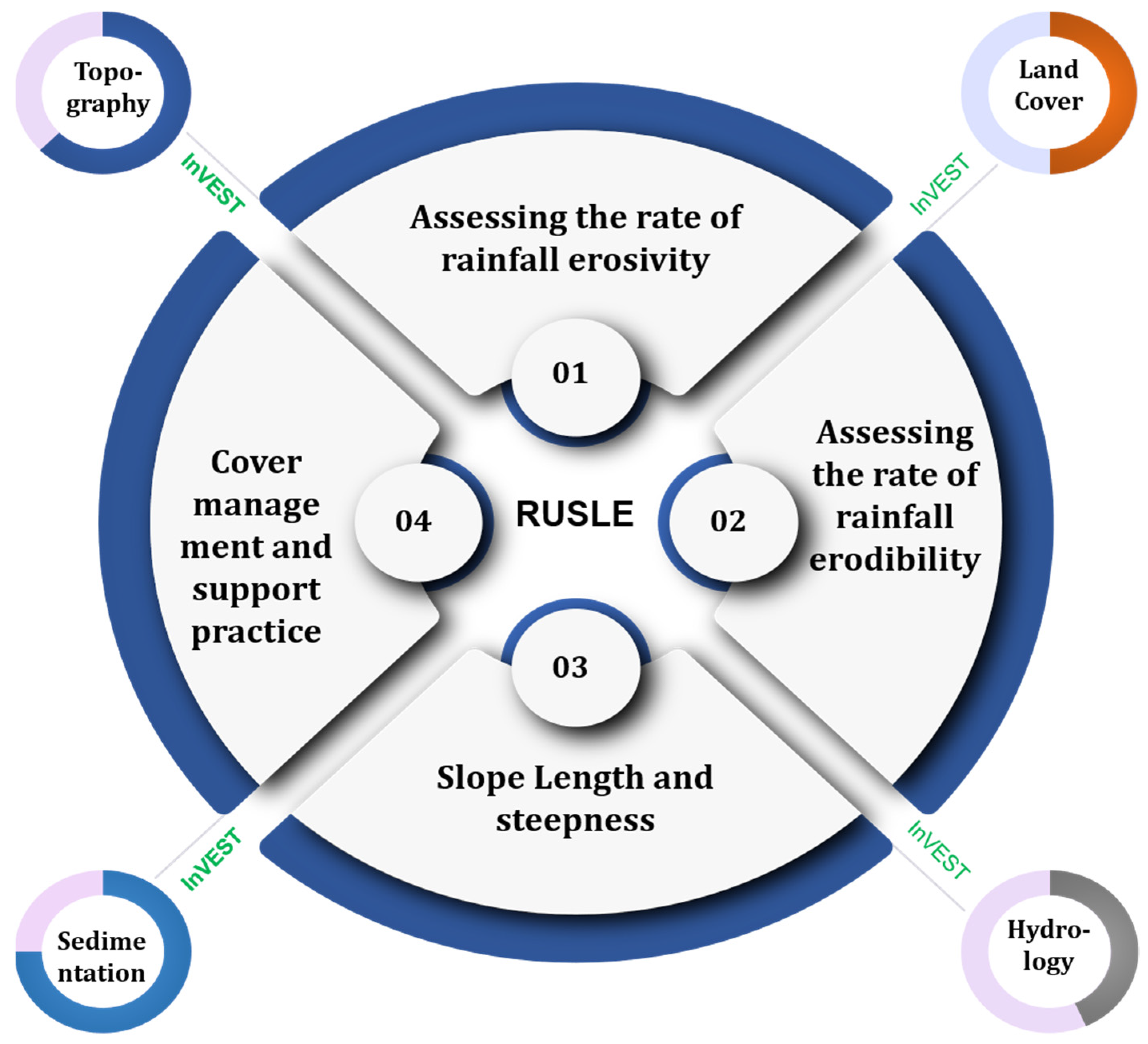


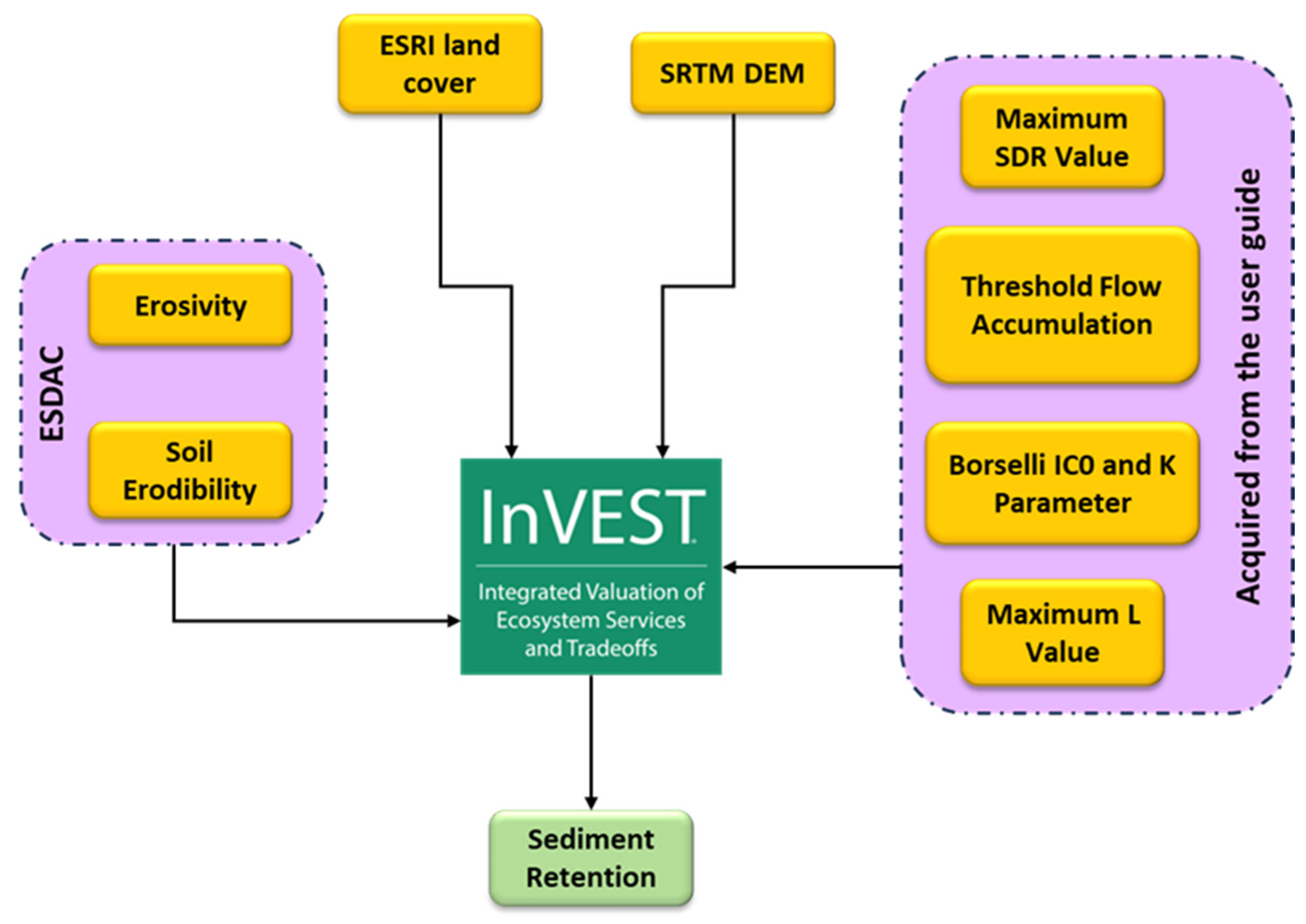
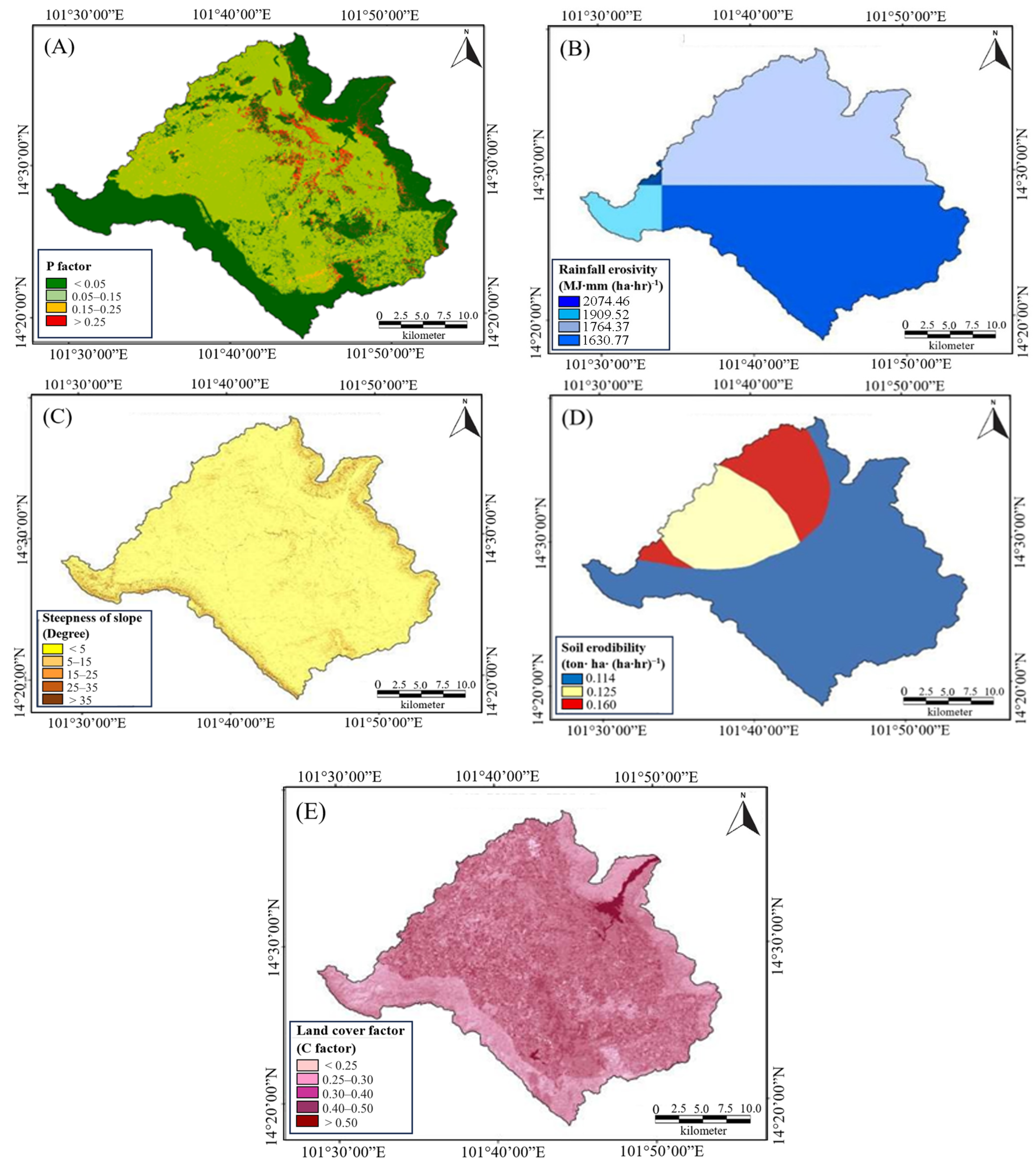
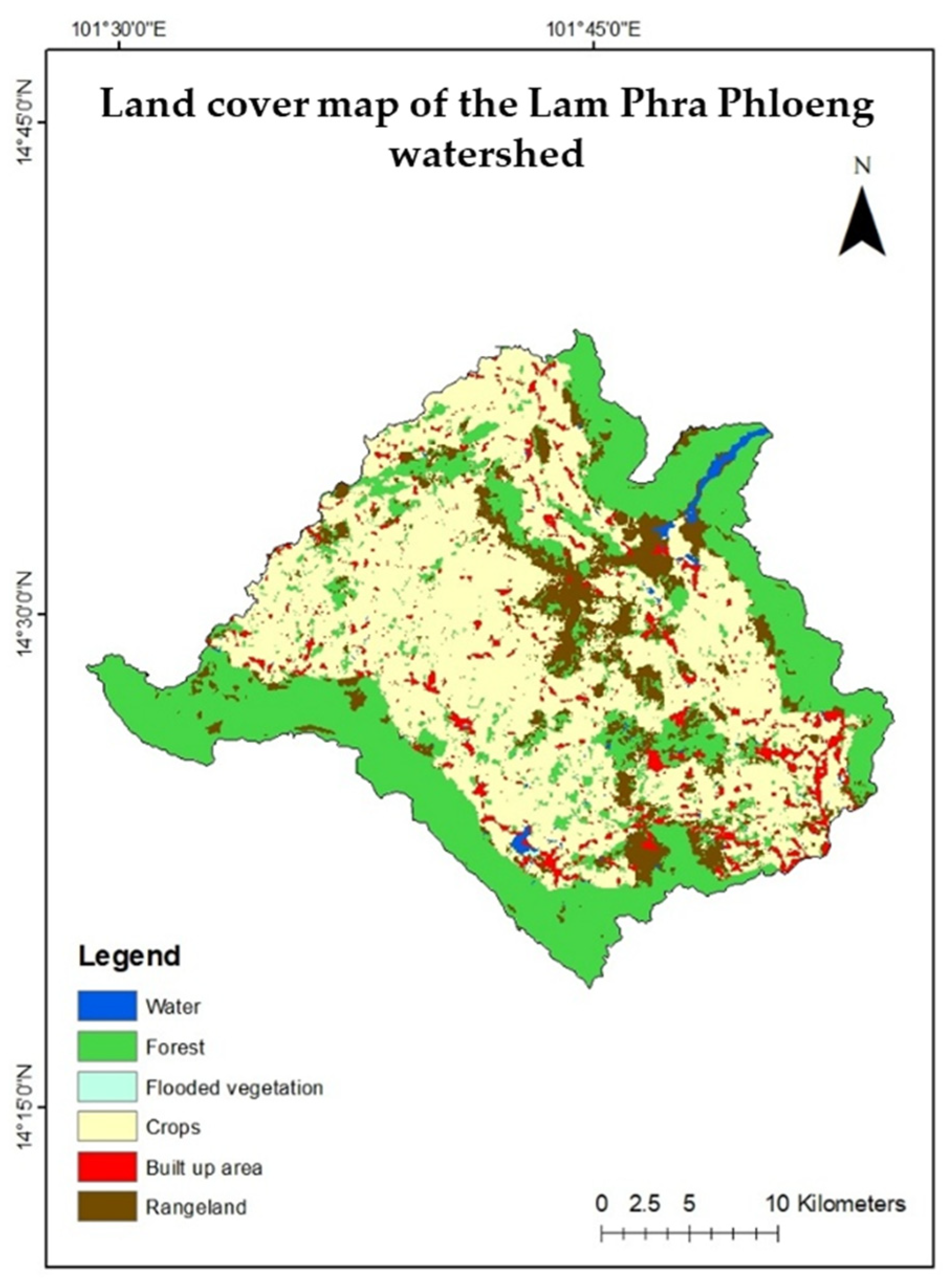
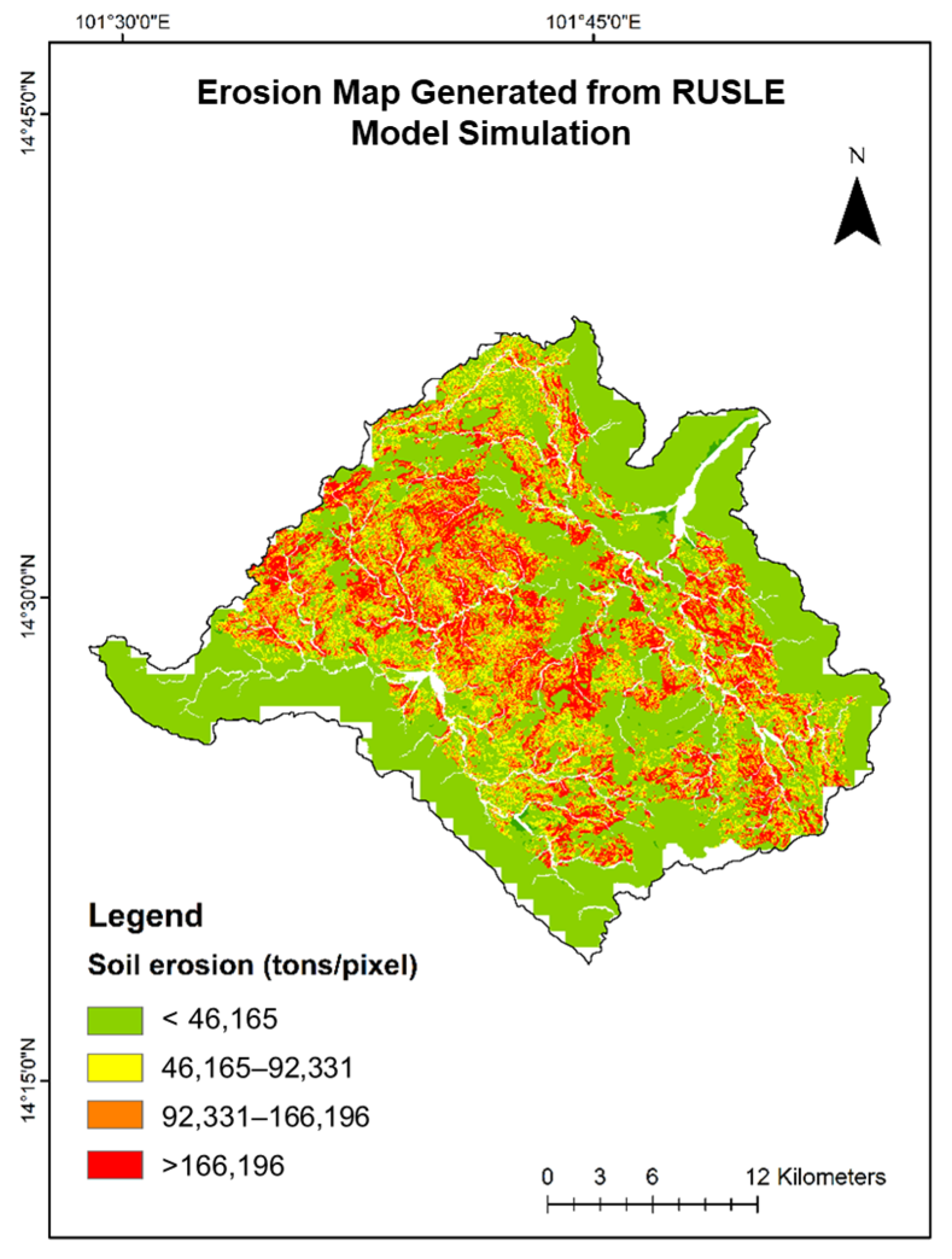



| Data Used | Description | Source |
|---|---|---|
| ASTER GDEM | The Global Digital Elevation Model (GDEM) is the product of the Advanced Spaceborne Thermal Emission and Reflection Radiometer (ASTER). | https://earthexplorer.usgs.gov/ (accessed on 17 December 2024) |
| Soil data | A global dataset that contains soil properties and soil classification | https://www.fao.org/soils-portal/data-hub/soil-maps-and-databases/en/ (accessed on 17 December 2024) |
| Climate data | Gridded weather and climate data | https://www.worldclim.org/ (accessed on 17 December 2024) |
| Land use land cover | Land use land cover map derived from Sentinel 2 MSI satellite imagery | https://browser.dataspace.copernicus.eu/ (accessed on 17 December 2024) |
| Data Used | Description | Source |
|---|---|---|
| Land use/land cover | Land use and land cover classification of the study area | https://livingatlas.arcgis.com/landcover/ (accessed on 17 December 2024) |
| SRTM DEM | Digital Elevation Model represents the elevation variation in the study area | https://www.earthdata.nasa.gov/ (accessed on 17 December 2024) |
| Watershed boundary | Shapefile of LPP watershed boundary | https://diva-gis.org/data.html (accessed on 17 December 2024) |
| Erosivity | Rainfall erosivity reflects the intensity and duration of rainfall in the area of interest. | https://esdac.jrc.ec.europa.eu/content/global-rainfall-erosivity (accessed on 17 December 2024) |
| Soil Erodibility | Soil erodibility is the susceptibility of soil particles to detachment and transport by rainfall and runoff. | https://esdac.jrc.ec.europa.eu/content/global-soil-erodibility (accessed on 17 December 2024) |
| Maximum SDR | Theoretical maximum sediment delivery ratio. It is the highest possible fraction of eroded sediment that can reach a river or stream channel (0.80) | [28] |
| Threshold Flow Accumulation | The density and structure of the river network extracted from a Digital Elevation Model (1000) | [28] |
| Borselli IC0 | Connectivity index at the start point (0.5) | [29] |
| Borselli K Parameter | shape of the relationship between hydrologic connectivity and the nutrient delivery ratio (2.4) | [29] |
| Maximum L value | The maximum allowed value of the slope length parameter (122) | [30] |
| Accuracy Table for RF Classification | ||||
|---|---|---|---|---|
| User Accuracy (%) | Producer Accuracy (%) | Overall Accuracy (%) | Kappa Coefficient | |
| Water | 96.1 | 95.2 | 91.3 | 0.89 |
| Forest | 91.5 | 92.8 | ||
| Flooded vegetation | 86.7 | 86.7 | ||
| Crops | 90.4 | 89.3 | ||
| Built-Up Area | 93.2 | 94.7 | ||
| Rangeland | 85.9 | 87.1 | ||
| Study Area | Rate of Erosion/Rate of Soil Loss | Reference |
|---|---|---|
| Songkhla, Thailand | 10,293 tons/km2 | [51] |
| Ing Watershed, Thailand | 29.64 tons/km2 | [52] |
| Pasak River Basin, Thailand | 673 tons/km2 | [53] |
| Lam Phra Phloeng (LPP) watershed | 6000 tons/km2 | [56] |
| Lam Phra Phloeng (LPP) watershed | 3140 tons/km2 | [57] |
| Lam Phra Phloeng (LPP) watershed | 6429 tons/km2 | [58] |
| Lam Phra Phloeng reservoir | 500 tons/km2 | [25] |
| Lam Phra Phloeng (LPP) watershed | 196,771 tons/km2 | [59] |
Disclaimer/Publisher’s Note: The statements, opinions and data contained in all publications are solely those of the individual author(s) and contributor(s) and not of MDPI and/or the editor(s). MDPI and/or the editor(s) disclaim responsibility for any injury to people or property resulting from any ideas, methods, instructions or products referred to in the content. |
© 2025 by the authors. Licensee MDPI, Basel, Switzerland. This article is an open access article distributed under the terms and conditions of the Creative Commons Attribution (CC BY) license (https://creativecommons.org/licenses/by/4.0/).
Share and Cite
Seeboonruang, U.; Mandadi, R.; Thammaboribal, P.; Gonzales, A.L.; Bharadwaz, G.S.V.S.A. Estimation of Soil Erosion and Enhancing Sediment Retention in the Lam Phra Phloeng Watershed: Insights from RUSLE and InVEST Modelling. Water 2025, 17, 3339. https://doi.org/10.3390/w17233339
Seeboonruang U, Mandadi R, Thammaboribal P, Gonzales AL, Bharadwaz GSVSA. Estimation of Soil Erosion and Enhancing Sediment Retention in the Lam Phra Phloeng Watershed: Insights from RUSLE and InVEST Modelling. Water. 2025; 17(23):3339. https://doi.org/10.3390/w17233339
Chicago/Turabian StyleSeeboonruang, Uma, Ranadheer Mandadi, Prapas Thammaboribal, Arlene L. Gonzales, and Ganni S. V. S. A. Bharadwaz. 2025. "Estimation of Soil Erosion and Enhancing Sediment Retention in the Lam Phra Phloeng Watershed: Insights from RUSLE and InVEST Modelling" Water 17, no. 23: 3339. https://doi.org/10.3390/w17233339
APA StyleSeeboonruang, U., Mandadi, R., Thammaboribal, P., Gonzales, A. L., & Bharadwaz, G. S. V. S. A. (2025). Estimation of Soil Erosion and Enhancing Sediment Retention in the Lam Phra Phloeng Watershed: Insights from RUSLE and InVEST Modelling. Water, 17(23), 3339. https://doi.org/10.3390/w17233339






